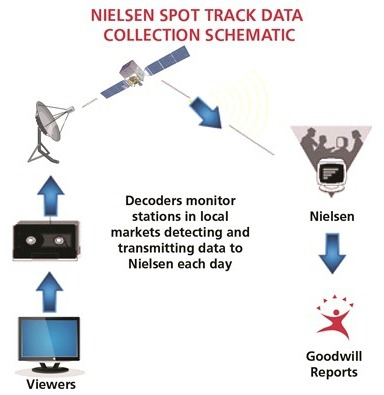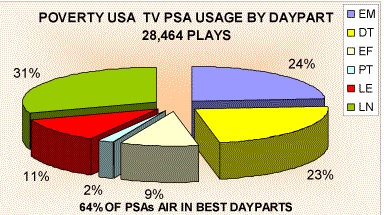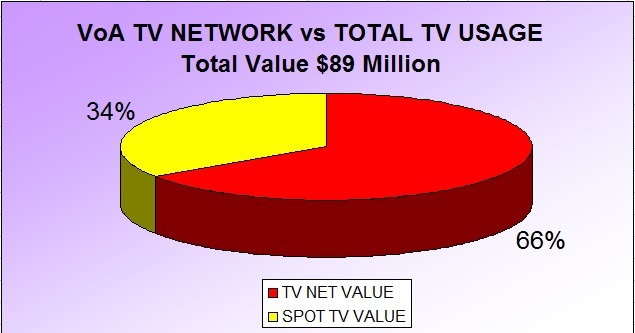![]()

PASSIVE vs ACTIVE PSA EVALUATION
by Bill GoodwillOne of the most important advancements in the field of public service advertising is the A.C. Nielsen electronic monitoring system, now known As SpotTrac. Prior to that time, the only method of evaluating the usage of PSAs in broadcast and cable media was to place a business reply card (BRC) in the PSA package distributed to stations.
Although everyone who used the BRC evaluation technique knew that it was not entirely accurate, prior to Nielsen monitoring data BRCs were the only method available to track usage, and the assumption was that it is better to have some data than none at all. .
However, any time there is human involvement in a process, particularly when that process gains no revenue to the organization providing the service, there is bound to be resistance and room for error. Such is the case with evaluating BRCs that public service directors must "actively" complete and return to the evaluator. Also, many television station public service directors are not sure of the airplay schedule for any given PSA.
Most TV PSAs are placed in automated "rotation," and the public service director normally does not get affidavits to show usage. Although stations are required to maintain broadcast logs, many of them are not computerized. And due to the tremendous number of PSAs in a station's inventory at any given time, it is not feasible to report PSAs aired for every PSA campaign used by a station. Accordingly, much of BRC reporting involves "guesstimates" based on likely or projected usage.
Adding to the problem, PSAs can get pre-empted by a paid commercial at the last moment, perhaps even after the public service director has returned the evaluation bounce-back card. Finally, our campaign experience shows that typically 80 percent of BRCs are not returned by stations unless the evaluator uses more aggressive follow-up techniques such as phone surveys or mailgrams.
A New Evaluation Paradigm
To provide clients with a more accurate method of evaluation, Goodwill Communications has been using the A.C. Nielsen "SIGMA" electronic monitoring service since January, 1995. To track usage via this system, an invisible code is placed on the master tape and then replicated on all tapes that are distributed to stations.
Nielsen monitoring equipment tracks PSAs using this code in all 213 DesignatedMarkets Areas (DMAs) and we download weekly raw data from Nielsen, add value to the data set and then post PSA evaluation data on our client reporting portals reflecting airplay from both actual (SIGMA) and projected (BRC) sources. However our software is programmed to avoid redundant reporting between these two sources. The graph below shows the Nielsen-to-Goodwill data collection and reporting process.
Passive vs Active Monitoring
Another distinct advantage of passive monitoring techniques is that we can show clients the specific time when their PSAs aired. By analyzing the daypart for PSA usage, we have a much better idea of the types of audiences we are reaching with our PSAs than was ever possible using the BRC evaluation technique.
The chart below depicts Nielsen daypart data for 6 different times of day. As shown, almost two-thirds of TV PSAs ran during the most desirable dayparts from 9 a.m.-1O p.m. This data contradicts the view that PSAs run only during "junk" time.
The Nielsen tracking provides a lot of other qualitative and quantitative data on PSA usage and to see some of the ways we use this data in our client reports, click here
Network Monitoring
Initially, even with the SpotTrac monitoring system, network data was sparse, but that has improved immensely over time. Now Nielsen monitors just about all the 130 national broadcast and cable networks to which we typically send PSAs. About three years ago we began testing personal outreach to all the national networks to "pitch" our client PSAs to them and what a difference this has made! For one of our clients - Volunteers of America - network PSA usage amounted to two-thirds of all value generated.
To track network commitments, our outreach specialist keeps an Excel spreadsheet, recording whom she spoke with at the network, any special requirements they need and the outcome of her discussion. Our software creates a separate network report, so we can compare the network verbal commitments to what is actually airing and we use this as the basis of another follow-up call to the network to gently encourage them to meet their usage commitment. It is tedious work, but the results are worth it as shown by this graph.
BRC Advantages
In spite of the advantages of passive monitoring, very legitimate reasons exist for continuing to use BRCs which include:
- They allow us to keep our database up to date with current contact information and dub format preferences
- If a station "steps on" the Nielsen code by doing any type of editing to the PSAs, it can affect how much usage data we get
- Nielsen does not monitor local cable so if we did not use BRCs, we would get no usage data at all
Clearly the die has been cast, however, in favor of more sophisticated evaluation methods for TV - a trend that will continue as electronic tracking procedures proliferate among cable TV, and radio.


